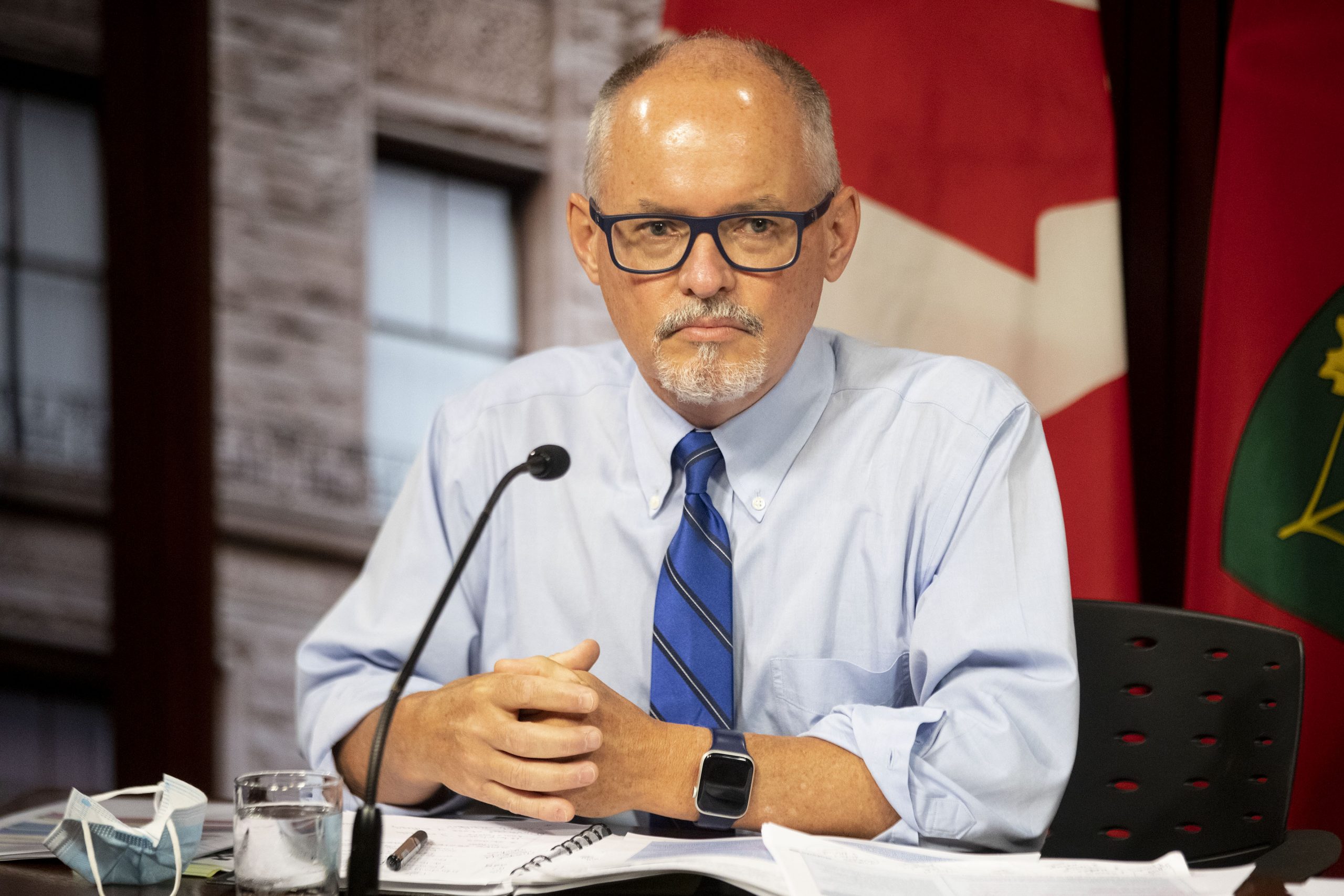Ontario is rolling out a rapid COVID-19 testing program for schools in areas of the province with high transmission.
Dr. Kieran Moore, the province’s chief medical officer of health, said Tuesday rapid tests will be made available as determined by local medical officers of health. Parents will be able to choose if their children participate in the screening.
“This will help identify and prevent transmission in schools and licensed child-care settings, as identified by local medical officers of health based on local epidemiological circumstances,” the province said.
The rapid tests will be used only for unvaccinated students with no symptoms who are not high-risk contacts of a case.
If a child receives a positive result, they will still need to get a lab-based PCR test to confirm.
“Routine rapid antigen screening of fully vaccinated individuals and children is not currently recommended given the effectiveness of the COVID-19 vaccines as well as the risks posed to the disruption of learning as a result of false positives,” Moore said in a release.
The announcement comes after groups of parents had organized surveillance testing for their schools using the rapid test kits, but the government told agencies to stop distributing them to anyone but businesses.
Below is the procedure and criteria for the COVID-19 rapid antigen screening for child-care and school age children (as provided by the province):
- Based on the guidance of the Chief Medical Officer of Health, local Medical Officers of Health will continue to monitor local COVID-19 transmission and vaccination rates to identify when to implement rapid antigen screening in parts of their region based on local factors and needs.
- Rapid antigen screening will be used only for unvaccinated asymptomatic students and children who are not high-risk contacts. Symptomatic or high-risk contacts should continue to access lab-based PCR testing available at assessment centres and other collection centres.
- Where the local public health unit has identified schools or child care centres that would benefit from this screening, rapid antigen screening tests will be made available. Parents will be able to choose if their unvaccinated asymptomatic children will participate in this screening offered by their schools or licensed child care settings.
- Unvaccinated children participating in the program will be able to conduct the rapid antigen screening at home with instructions.
- Children who receive a positive result will be required to seek a confirmatory lab-based PCR test at a local assessment centre or specimen collection centre and isolate until the result of that lab-based PCR test is known. Children who receive a negative result on a rapid antigen screening test will be able to continue in-person learning. More detailed information including duration and frequency will follow.
More to come

A man is in hospital after he was struck by a vehicle on Highway 401 while trying to help following a crash in the area.
It happened around 1 a.m. Tuesday on the westbound lanes of the highway near the Renforth bridge.
The man was rushed to hospital with serious but not life-threatening injuries.
Provincial police said a vehicle with three people inside stopped to help after a tractor-trailer jack-knifed on the westbound lanes of the 401 at Highway 427.
An oncoming SUV then hit the truck. It appears the truck then struck one of the people who stopped to help.

A former Facebook data scientist has stunned lawmakers and the public with revelations of the company’s awareness of apparent harm to some teens from Instagram and her accusations of dishonesty in its fight against hate and misinformation. Now she is coming before Congress.
Frances Haugen has come forward with a wide-ranging condemnation of Facebook, buttressed with tens of thousands of pages of internal research documents she secretly copied before leaving her job in Facebook’s civic integrity unit. Haugen also has filed complaints with federal authorities alleging that Facebook’s own research shows that it amplifies hate, misinformation and political unrest, but the company hides what it knows.
After recent reports in The Wall Street Journal based on documents she leaked to the newspaper raised a public outcry, Haugen revealed her identity in a CBS “60 Minutes” interview aired Sunday night. She insisted that “Facebook, over and over again, has shown it chooses profit over safety.”
RELATED:
The ex-employee challenging the social network giant with 2.8 billion users worldwide and nearly $1 trillion in market value is a 37-year-old data expert from Iowa with a degree in computer engineering and a master’s degree in business from Harvard. She worked for 15 years prior to being recruited by Facebook in 2019 at companies including Google and Pinterest.
Haugen is set to testify to the Senate Commerce subcommittee on consumer protection at a hearing Tuesday.
The panel is examining Facebook’s use of information from its own researchers on Instagram that could indicate potential harm for some of its young users, especially girls, while it publicly downplayed the negative impacts. For some of the teens devoted to Facebook’s popular photo-sharing platform, the peer pressure generated by the visually focused Instagram led to mental health and body-image problems, and in some cases, eating disorders and suicidal thoughts, the research leaked by Haugen showed.
One internal study cited 13.5% of teen girls saying Instagram makes thoughts of suicide worse and 17% of teen girls saying it makes eating disorders worse.
“And what’s super tragic is Facebook’s own research says, as these young women begin to consume this eating disorder content, they get more and more depressed,” Haugen said in the televised interview. “And it actually makes them use the app more. And so, they end up in this feedback cycle where they hate their bodies more and more.”
As the public relations debacle over the Instagram research grew last week, Facebook put on hold its work on a kids’ version of Instagram, which the company says is meant mainly for tweens aged 10 to 12.
The senators are eager to hear from Haugen.
“I look forward to asking her follow-up questions about why Facebook hasn’t taken action to fix problems on its platforms, even when its own internal research reflects massive problems,” Sen. Amy Klobuchar, D-Minn., a member of the subcommittee, told The Associated Press on Monday. “I want to discuss how Facebook’s algorithms promote harmful and divisive content, and how much Facebook really profits off of our children.”
At issue are algorithms that govern what shows up on users’ news feeds, and how they favor hateful content. Haugen said a 2018 change to the content flow contributed to more divisiveness and ill will in a network ostensibly created to bring people closer together. Despite the enmity that the new algorithms were feeding, Facebook found that they helped keep people coming back — a pattern that helped the social media giant sell more of the digital ads that generate most of its revenue.
RELATED:
Haugen’s criticisms range beyond the Instagram situation. She said in the interview that Facebook prematurely turned off safeguards designed to thwart misinformation and incitement to violence after Joe Biden defeated Donald Trump last year, alleging that contributed to the deadly Jan. 6 assault on the U.S. Capitol.
After the November election, Facebook dissolved the civic integrity union where Haugen had been working. That, she said, was the moment she realized “I don’t trust that they’re willing to actually invest what needs to be invested to keep Facebook from being dangerous.”
Haugen says she told Facebook executives when they recruited her that she had asked to work in an area of the company that fights misinformation, because she had lost a friend to online conspiracy theories.
Antigone Davis, Facebook’s head of global safety, faced a barrage of criticism from senators on the Commerce panel at a hearing last Thursday. They accused Facebook of concealing the negative findings about Instagram and demanded a commitment from the company to make changes.
Davis defended Instagram’s efforts to protect young people using its platform. She disputed the way The Wall Street Journal story describes what the research shows.
Facebook maintains that Haugen’s allegations are misleading and insists there is no evidence to support the premise that it is the primary cause of social polarization.
“Even with the most sophisticated technology, which I believe we deploy, even with the tens of thousands of people that we employ to try and maintain safety and integrity on our platform, we’re never going to be absolutely on top of this 100% of the time,” Nick Clegg, Facebook’s vice president of policy and public affairs, said Sunday on CNN’s “Reliable Sources.”
That’s because of the “instantaneous and spontaneous form of communication” on Facebook, Clegg said, adding, “I think we do more than any reasonable person can expect to.”
By coming forward, Haugen says she hopes it will help spur the government to put regulations in place for Facebook’s activities. Like fellow tech giants Google, Amazon and Apple, Facebook has for years enjoyed minimal regulation in Washington.
Separately Monday, a massive global outage plunged Facebook, Instagram and the company’s WhatsApp messaging platform into chaos, only gradually dissipating by late Monday Eastern time. For some users, WhatsApp was working for a time, then not. For others, Instagram was working but not Facebook, and so on.
Facebook didn’t say what might have caused the outage, which began around 11:40 a.m. EDT and was still not fixed more than six hours later.
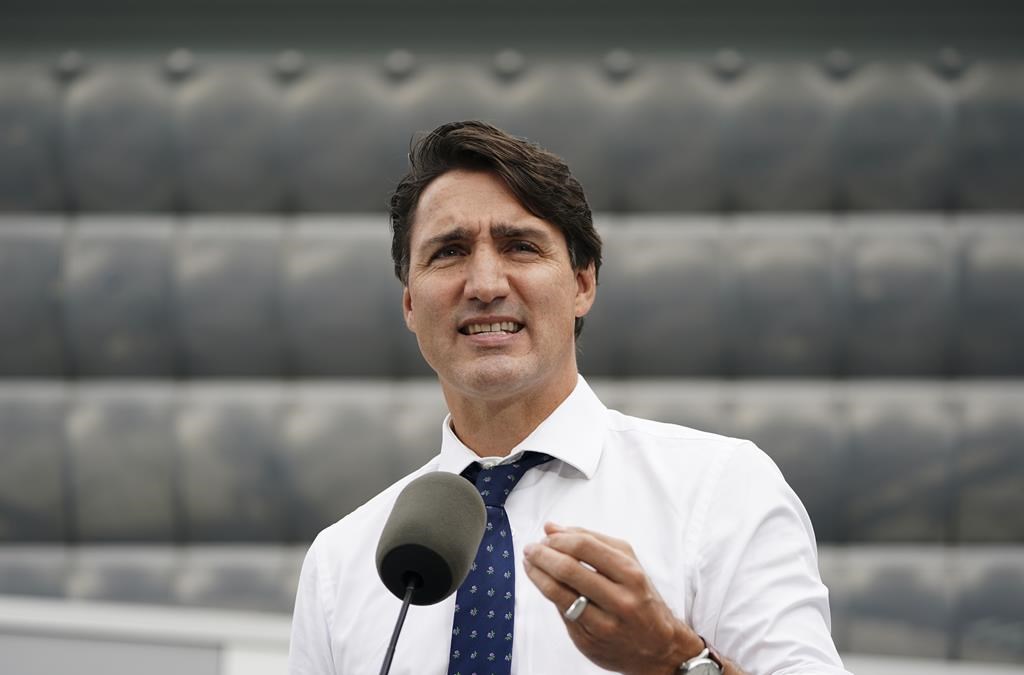
Prime Minister Justin Trudeau will be back in Ottawa on Tuesday following his untimely Tofino vacation on the first National Day for Truth and Reconciliation.
Trudeau apologized to B.C. Indigenous leaders over the weekend, but has yet to speak publicly on the matter.
The Prime Minister attended a truth and reconciliation event last Wednesday night – the next day his itinerary did not mention that he was flying out west to Tofino. The itinerary simply said he would be conducting private meetings in Ottawa.
The same thing is listed on Trudeau’s itinerary for Tuesday.
On Sunday, Trudeau’s press secretary confirmed that he had reached out to the chief of the Tk’emlúps te Secwepemc First Nation Saturday and offered an apology for not responding to invitations to visit the community.
PM spokesperson Ann-Clara Vaillancourt told 680 NEWS “He reached out [Saturday], spoke with the Chief, offered an apology, discussed the path forward and is looking forward to visiting the community soon.”
Assembly of First Nations National Chief RoseAnne Archibald said the PM’s apology fell short.
“As I stated to the Catholic church, hollow apologies will no longer be accepted. As National Chief, on behalf of all First Nations, I expect concrete action and changed behaviours. The Prime Minister must demonstrate through actions that he is committed to the healing path forward,” she said.
Meanwhile, Timmins-James Bay MP Charlie Angus will be holding a news conference on Tuesday morning and calling on the federal government to take concrete steps towards reconciliation in this country.
Erin O’Toole faces caucus
Erin O’Toole’s leadership will face its first test since the Conservative Party’s disappointing election defeat two weeks ago.
The 119 Conservative MPs are set to gather in person in Ottawa where they will have to decide whether they want the power to review O’toole’s leadership.
Under legislation passed in 2015, each party’s caucus is required to decide after an election whether it wants to empower its members to trigger a leadership review. The review requires a written notice backed by at least 20 per cent of caucus.
Several conservative MPs, speaking to the Toronto Star on the condition of anonymity, say they believe their colleagues could vote in favour of launching a leadership review but tell the paper where was no sign on Monday that anyone was actively gathering signatures.
With files from the Canadian Press
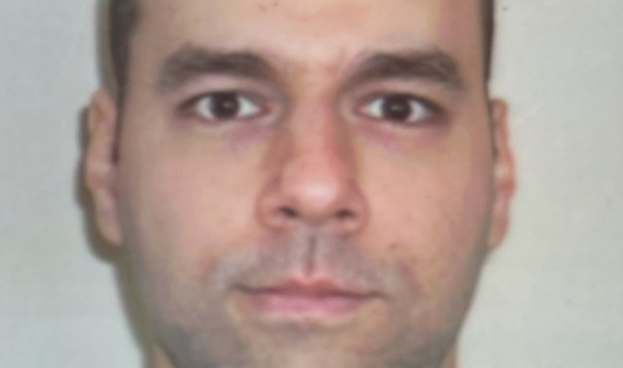
Peel police have issued a public safety warning while they search for a missing man believed to be in crisis and in possession of firearms.
Police say Ruben Mukja, 33, was reported missing on Sunday, October 3 at around 9:40 a.m. from the Westminster Place and Rathburn Road East area of Mississauga.
He was last seen on Saturday, October 2 at around 10:30 p.m.
“As the investigation has unfolded, police have learned that Ruben Mukja is believed to be in a state of crisis and may be in possession of several firearms,” police said in a release.
He’s described as male, five foot nine, with a a medium build and short brown hair. Mukja was last seen wearing an olive green windbreaker jacket, white running shoes and a black backpack.
Police say if you see Mukja, don’t approach him and call 911.
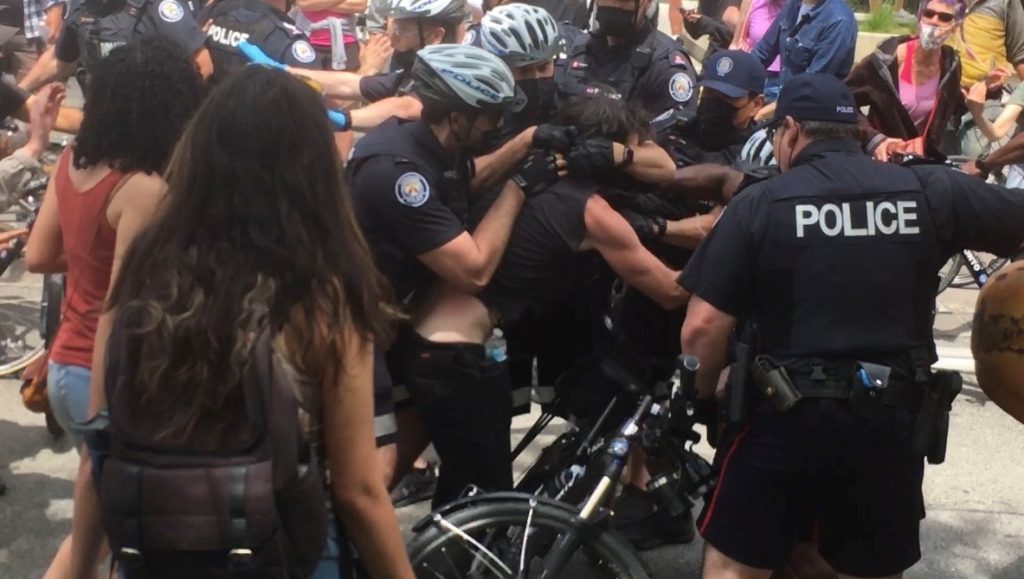
Two Toronto city councillors are putting forward a motion to call for a judicial inquiry into the controversial clearing of encampments.
Josh Matlow and Mike Layton say the role of the police in the clearings deserves a thorough investigation that can only be achieved through an external party.
It cost the city nearly $2-million to remove encampments at Trinity Bellwoods, Alexandra Park, and Lamport Stadium over the summer, angering protesters who frequently clashed with police while they evicted people who had been living at the parks.
The city also spent more than $790,000 to clean up the three parks, including removing debris.
Matlow and Layton say the videos that circulated in the media showed a use of force that is “unprecedented” and “unacceptable,” and that there is a critical need to examine what happened.
The motion will be presented at city council Monday.
Last week, the office of Toronto’s Ombudsman announced that it has launched an investigation into the clearings.
Kwame Addo said they have received complaints about the way the city handled encampment evictions and the City Manager has been formally notified of the investigation.
“The investigation will focus on how the City of Toronto planned the encampment clearings, engaged stakeholders, and communicated with the public, as well as the policies and procedures that guided its actions,” the Ombudsman’s office said in a release.
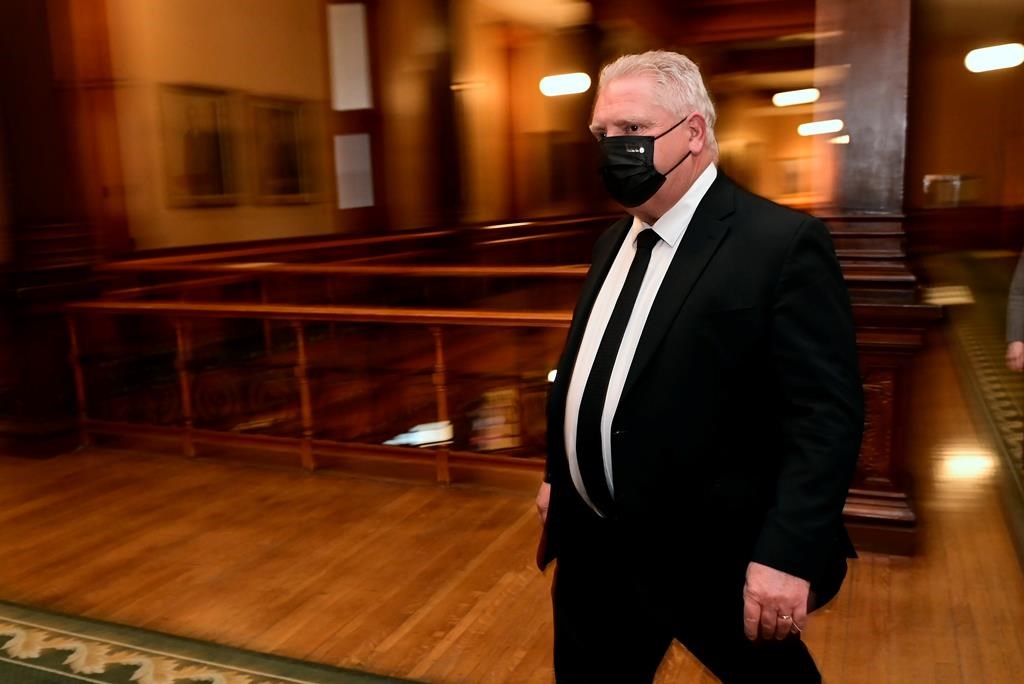
Premier Doug Ford will offer a fresh agenda Monday through a throne speech expected to focus on pandemic recovery, but may hint at new policies ahead of the next election, as some major promises from 2018 remain unfulfilled.
The speech, which comes after he prorogued the legislature, ending a more than three-year session, marks Ford’s first real chance to reset his roadmap for the province since his Progressive Conservatives won a majority government.
Since then, he has accomplished much of the roughly 60 promises in his election platform, though most of the signature ones are not checked off.
Income taxes have not been cut, gas prices are not 10 cents lower, and beer and wine are not sold in corner stores.
The pandemic changed priorities for governments and individuals alike, and the province has focused much of its energy and spending on recovery. That may mean that there is little time and money left to accomplish the rest of the promises made before COVID-19 plunged the world into turmoil.
A spokeswoman for the premier said the speech from the throne will be “overwhelmingly focused” on the ongoing fight against COVID-19.
Mitchell Davidson, Ford’s former executive director of policy, said one unfulfilled 2018 promise he thinks is most likely to still be in Ford’s plans is an income tax cut, as it could be used to spur pandemic recovery.
“There’s a lot of different arguments and cases that can be made for some form of broad-based tax relief, for government to reduce the cost of living in a way that it can control …it can actually put more money back into people’s pockets,” said Davidson, now the executive director of the StrategyCorp Institute of Public Policy and Economy.
“What an interesting opportunity to both do what you said you were going to do and also do something that will be inherently popular and needed for people right now.”
Finance Minister Peter Bethlenfalvy’s spokeswoman, Emily Hogeveen, said, “any tax changes must be considered in the context of other government priorities and the overall fiscal situation while Ontario continues to address the impact of the COVID-19 pandemic.”
Ford also promised in 2018 to cut gas prices by 10 cents. Ending the previous Liberal government’s cap-and-trade system was to lower prices by 4.3 cents and the rest would come from cutting the provincial fuel tax.
The Progressive Conservatives did end cap and trade, but that meant the federal carbon tax backstop kicked in, negating savings at the pump. Ford’s government tried fighting it in court, but lost. The provincial fuel tax rate remains unchanged from 2018.
Dan Moulton, a vice-president at Crestview Strategy and former senior Liberal staffer, said the pandemic so far has allowed Ford to present a coherent agenda of battling COVID-19 and recovering from it, but as it starts to recede he’ll need to lay out what happens beyond the current crisis.
“This throne speech, I think, provides them the first opportunity to establish a vision for what they actually plan to do,” he said.
“I think the government is going to face critiques over the course of the next eight months or so over those certain things they have yet to fulfil – hydro rates probably the most glaring because they attached a 12-per-cent reduction number to it.”
The Progressive Conservatives promised in 2018 to lower hydro bills by 12 per cent at a time when high bills were a key election issue. A spokesman for the Ministry of Energy noted that a number of rate relief programs were introduced during the pandemic, and that savings first introduced by the previous Liberal government are continuing.
Moulton said the government has likely discovered cutting hydro bills in Ontario is very difficult.
“I think the government’s preference will likely be to talk as little about electricity prices in advance of the election as possible,” he said.
“It’s not a winning issue for them, it’s not a winning issue for anyone, and, frankly, I don’t think it’s top of mind for voters.”
When it comes to putting beer and wine in corner stores, the one-time banner election promise had already seemingly fallen down the government’s to-do list before the pandemic hit. After Rod Phillips was named finance minister in 2019, he didn’t take up the Beer Store sabre rattling of his predecessor.
Bethlenfalvy’s spokeswoman said a “comprehensive review of the beverage alcohol sector” is underway.
Davidson noted that the government has made a number of major moves on alcohol liberalization, such as permanently allowing restaurants to sell alcohol with take-out and delivery, appeasing consumers.
At this point Ford might as well just promise to let the Beer Store deal that effectively keeps beer out of corner stores expire in 2025 and not to renew it, he said.
Davidson suspects most of the throne speech will be high level, with perhaps one or two mentions of a big-ticket promise.
“I think on a whole it’s a very sobering experience for the government to go through,” he said.
“Lots has changed from the 2018 throne speech, so being sort of forced in a way to put some markers in the sand and define what you’re going to be about is a really important activity.”

A 14-year-old girl was seriously injured after being struck by a vehicle in Brampton.
Police say the girl was cycling in the area of Goreway Drive and Richgrove Drive when she was struck just before 7 p.m. Sunday.
The driver remained on the scene.
The girl was alert and conscious before being transported to a children’s trauma centre, where she was listed in stable condition with non-life threatening injuries.
It’s not clear if speed or weather conditions were factors at the time of the crash.
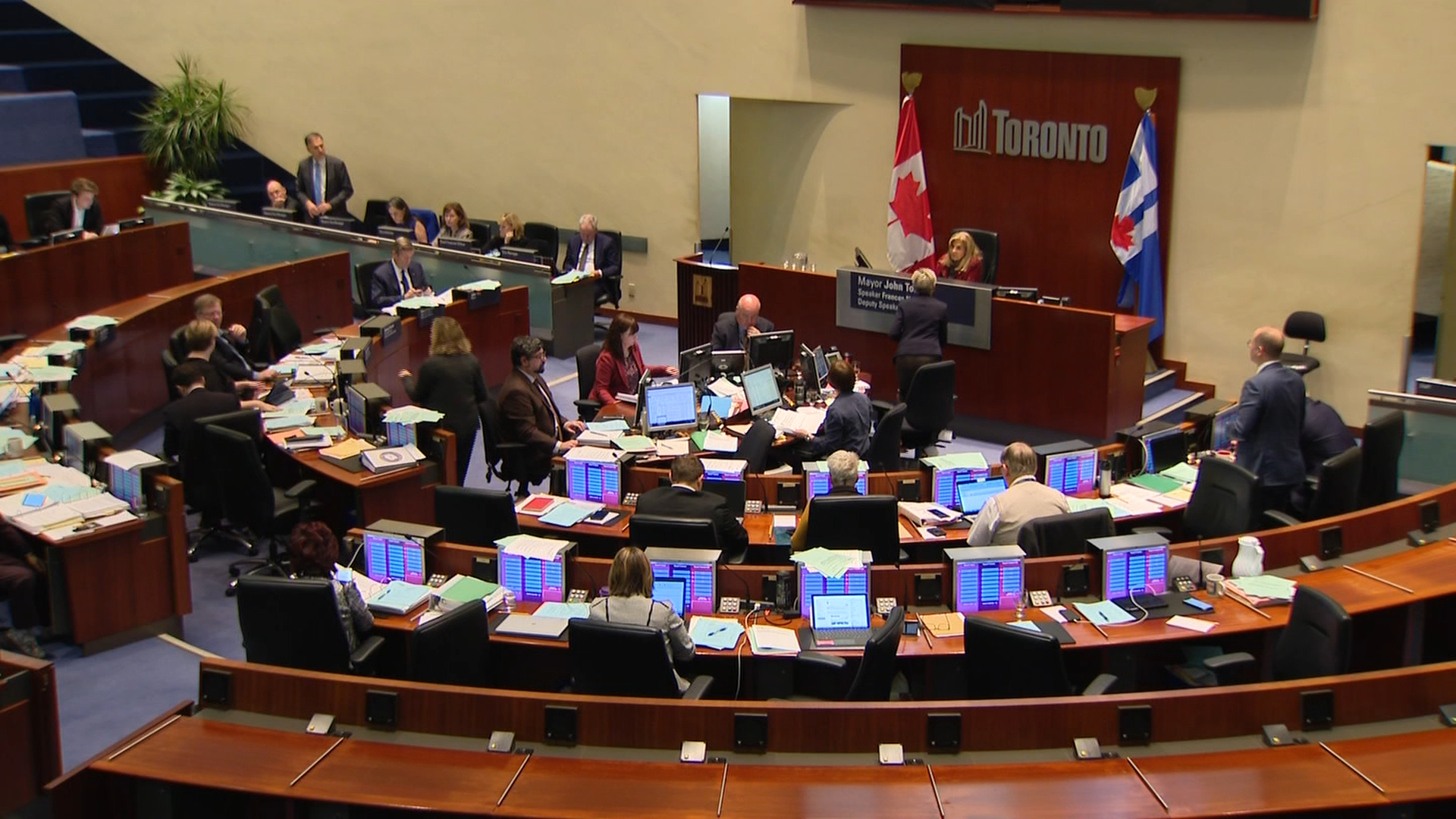
The country’s top court is set to rule today on whether Ontario Premier Doug Ford’s decision to slash the size of Toronto’s city council during the last municipal election was constitutional.
The Supreme Court of Canada decision is coming roughly a year before Ontario’s next municipal vote.
In 2018, the municipal campaign was well underway when the Ontario legislature passed a law that reduced the number of council seats in Toronto to 25 from 47, aligning them with federal ridings.
Ford — a former Toronto city councillor and failed mayoral candidate — argued at the time that the change would streamline council operations and save $25 million.
Critics, however, denounced it as undemocratic and arbitrary.
Toronto successfully challenged the legislation in Superior Court, with the judge deeming it unconstitutional.
Ford threatened to use the Constitution’s notwithstanding clause to push through the change but didn’t have to invoke it because the province won a stay of the decision pending appeal.
Ontario’s top court then delivered a split decision on the matter, with three judges ruling to overturn the Superior Court decision and two to uphold it.
The Supreme Court of Canada agreed to hear the city’s challenge of the Appeal Court ruling, with a hearing held in March.

Aaron Judge’s second home run of the game as part of a three-home run barrage in the sixth inning powered the New York Yankees to a 6-2 win over the Blue Jays, dealing another blow to Toronto’s wild-card playoff hopes.
Judge opened the scoring with his 38th homer of the year in the first off starter Robbie Ray.
The Blue Jays responded in the bottom half of the second as Bo Bichette scored on Corey Dickerson’s double. Toronto then took a 2-1 lead in the bottom of the fifth when Vladimir Guerrero Jr. doubled home Marcus Semien.
The Yankees then blew open the game in the sixth inning as Anthony Rizzo and Judge hit back-to-back home runs and Gleyber Torres slugged his ninth of the season with a batter on base for a 5-2 lead. That spelled the end of the night for Ray who gave up a season-high five earned runs on four hits – four of them home runs.
“They can hit. They’ve proven it all year,” Ray said “It’s a tough lineup from top to bottom. They’re a good hitting team for sure.”
The four home runs allowed matched Ray’s career-worst, set April 29, 2016 against Colorado while pitching for Arizona.
Brett Gardner added an insurance run with a solo home run in the ninth inning for New York, who have won eight of its last nine games to strengthen their grip on the first American League wild-card spot.
The good news for the Blue Jays is the Boston Red Sox lost to last-place Baltimore 6-2. The Orioles, who have lost 107 games this year, took two of three games in the series against Boston. The Red Sox are now tied with Seattle for the American League’s second wild card. Boston trails the Yankees by two games and leads the Blue Jays by one game.
Toronto opens a weekend series against the Orioles on Friday night. Steven Matz gets the start for Toronto. He is 1-1 with a 6.00 ERA in three starts against Baltimore this season.
“We’ve just got to go one game at a time and win every game now for sure,” manager Charlie Montoyo said.
